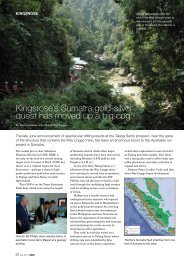Prospectus - Kingsrose Mining
Prospectus - Kingsrose Mining
Prospectus - Kingsrose Mining
You also want an ePaper? Increase the reach of your titles
YUMPU automatically turns print PDFs into web optimized ePapers that Google loves.
Section 1<br />
Investment Summary<br />
5. Project Geology (after Collins 2003, Swager 1994)<br />
5.1 Ora Banda Sequence at Comet Vale<br />
Mafic-ultramafic volcanic rocks in the Comet Vale area are a continuation of the lower part of the Ora Banda<br />
Sequence, though generally with reduced thickness.<br />
The mafic-ultramafic volcanics at Comet Vale is divided into three formations that are correlated with the<br />
Missouri Basalt, Walter Williams Formation and Siberia Komatiite.<br />
Only the Missouri Basalt and Walter Williams Formations outcrop in the vicinity of and along strike from the<br />
Sand Queen – Gladsome mine.<br />
The Wongi Basalt at the base of the Ora Banda Sequence is not apparent as outcrop within the project area,<br />
however younger formations may underlie the eastern part of the project area.<br />
The Missouri Basalt is the basal formation in the Comet Vale area consists of massive, fine to medium-grained<br />
metabasalt having a possible thickness in the vicinity of 500-1000m. The Missouri Basalt is conformably<br />
overlain to the east by ultramafic rocks of the Walter Williams Formation (Table 2).<br />
The Missouri Basalt may be divided into two distinct units, the upper and lower basalt. The boundary<br />
between them being about 200m below (and structurally above) the boundary of the Walter Williams<br />
Formation (Holla 2001). The Walter Williams Formation is dominated by serpentenised dunite and minor<br />
peridotite that outcrop east of the Goldfields Highway.<br />
The boundary between the Missouri Basalt and Walter Williams Formation appears to be a zone of shearing in<br />
talc-carbonate-chlorite altered ultramafics.<br />
5.2 Granitic Rocks<br />
There are two granitoids within the Comet Vale area.<br />
1. The Goongarrie Monzogranite forming the western margin of the Menzies Greenstone belt and<br />
underlying the western part of the project area.<br />
2. The Comet Vale Monzogranite, is a late tectonic granitoid that has intruded the greenstone belt<br />
intersecting the eastern margin of the Googarrie Monzogranite. This granitoid is circular in shape and<br />
truncates the mafic-ultramafic volcanic sequence in the northern part of the project area.<br />
The basaltic sequence has been intruded by several narrow porphyry dykes (or sills) that are generally subparallel<br />
to the stratigraphy. Most of these porphyry dykes occur at the top of the Missouri Basalt within some<br />
60m of its boundary with the overlying Walter Williams Formation, however some narrow dykes occur in the<br />
Walter Williams Formation.<br />
5.3 Structural Geology<br />
Comet Vale is on the western limb of the regional-scale north-south trending. Googarrie-Mt Pleasant<br />
anticline. The Googarrie Monzogranite is in the core of this south-plunging anticline, enclosed by rocks of<br />
the Ora Banda Domain. The mafic-ultramafic rocks of the Comet Vale Area are therefore part of the same<br />
sequence that is host to the Grants Patch, Ora Banda and Mt Pleasant gold mining centres on the southern and<br />
western limbs of this anticline (Figure 4).<br />
Close to its southern margin emplacement of the late-tectonic Comet Vale Monzogranite has caused distortion<br />
of the Missouri Basalt and Walter Williams Formation from a NNW-SSE trend to a more NW-SE trend. The<br />
Siberia komatiite appears to have been deflected in the opposite direction resulting in a NE-SW trend.<br />
Emplacement of the monzogranite appears to have been accommodated by faults and shear zones that are subparallel<br />
to the contact between the granitoid and the greenstone belt. These WNW-ESE-trending structures<br />
host some of the smaller gold deposits in the Comet Vale area, namely the Happy Jack, Lake View and Lady<br />
Margaret mines (Witt, 1990).<br />
In contrast, the largest gold deposit at Comet Vale, the Sand Queen-Gladsome mine, occurs in a NNW-SSE<br />
trending, steeply-west dipping structure which is sub-parallel to the boundary between the Missouri Basalt<br />
and Walter Williams Formation. Although the exact nature of this structure is not known it is not thought to<br />
be related to the emplacement of the Comet Vale Monzogranite.<br />
Page 24





